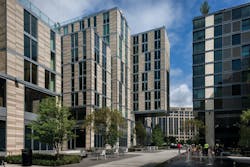An Argument Against Precast Preconceptions
April 1, 2016
Related To:
Often specified for its more utilitarian advantages, precast concrete might not be the exterior material of choice that first comes to mind for a signature high rise or cutting-edge boutique. However, Washington, D.C., architect Barry Habib, AIA, says the material offers numerous advantages for more workaday assignments, along with opportunities for creative expression for those willing to see a beauty that’s more than skin deep.
“It is tough, it lasts a long time, it doesn’t leak if it’s installed correctly—and we’re getting a very good price for it,” says this principal with D.C.-based Shalom Baranes Assocs. Plus, the speed with which precast exteriors can be assembled can be a boon for projects on tight deadlines. “For apartment buildings, getting them enclosed quickly is critical, because there is so much interior work to do.”
Habib and his colleagues at the firm are well-experienced in working with precast. Habib says Shalom Baranes has installed several-hundred-thousand sq. ft. over time, with a number of projects earning awards for their use of the material—including 2015 prizes from the Architectural Precast Assn. for City Center, a Washington, D.C., multifamily complex and a new D.C. headquarters for the Assn. of American Medical Colleges. Clients have come to appreciate its economy, strength and water tightness. Plus, in high-traffic areas, precast concrete
offers them great sound performance—a major plus along traffic corridors like the D.C. area’s notorious beltway, where sound codes might otherwise require expensive sound-insulation schemes.
“It’s quiet, it’s very quiet,” he says. “It’s better than the metal skins, in terms of sound performance.”
Habib also believes precast has gotten a bit of a bad rap on the issue of attractiveness, both on its own and as a backing for thin brick, terra cotta and other higher-design cladding materials. In these applications, in which the concrete is cast directly onto the cladding that has been pre-placed into forms, it can be an alternative to the rain screens that are becoming increasingly popular. And, even without added cladding, the material offers decorative advantages… “You can make it into almost any shape—you can form it into a unique shape and repeat it over and over again, once you’ve made the mold,” Habib says, noting the affordability of this approach. And he adds that the material’s tintability has drawn the attention of some signature architects in the not-so-distant past.
“Michael Graves did many projects with precast concrete, pushing it about as far as he could with the colors—the colors last,” he says. Additionally, because the tinting penetrates through the material, precast stands up to stains and graffiti that might permanently damage less durable material. “If something gets on it, you can clean it. It takes abuse.”
The architect has a few tips for other designers who might be new to working with precast concrete. First, he suggests becoming familiar with the standards published by the Precast Institute, especially when working with cast-in-place cladding, such as thin brick and terra cotta. Second, careful delineation of joint details is critical to successful installation.“The worst thing you can do with precast is put the panels too close to each other,” he says. “You need at least 0.75 in. or so between panels.” And, he adds, as in any project where close attention to tolerances is important, the right partners also are crucial to a successful project. “You need to have a good subcontractor and you need good erectors. It takes an experienced workforce.”
Sponsored Recommendations
Sponsored Recommendations
Sponsored
Sponsored


